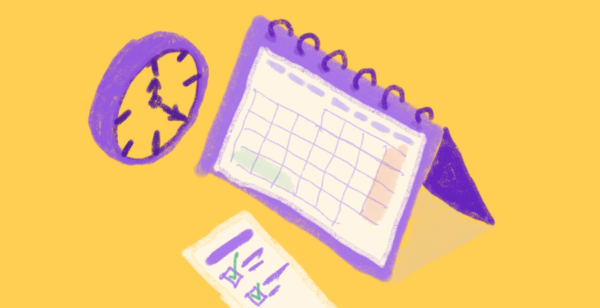Working from home can certainly have its perks, as many of us have witnessed first-hand in the days since the pandemic began. But sometimes it can be difficult to notice the progress we are making when we are in the thick of it in our personal home space so much of the time. Without outside perspective and interaction, things can be almost impossible to stay on top of, and even sometimes to keep track of. But there is something that can absolutely set you up for success in your career, no matter what working environment you may find yourself in.
1. Routine
Having any type of routine – be it work early and play later, vice versa, or allowing yourself to work at a more leisurely ebb and flow pace each day, among others – can help increase your productivity, whether you thrive throughout the day or require more rest to bring on spurts of inspiration. Routines are important to work toward and track for many reasons aside from the inspirational side of it all. They can help you feel secure and in control of your environment, which can help reduce your fight or flight response and effectively aid the overall health of your nervous system.
Having a set schedule can also encourage deeper knowledge around specific details of – or tasks in – your life and help you to engage in continued education. This deeper knowledge could lead to more innovation in your career space, or for a client. So, what can you do to better solidify your routine to create a productive work-from-home schedule – and ensure you stick to it?
2. Commit to a calendar
Whether you choose to keep your appointments and reminders on a digital to-do list or in a paper planner, make sure you are tracking your work schedule somewhere. With so many online and digital options integrated with other productivity apps, there is undoubtedly something out there for everyone.
And we understand that sometimes, there’s nothing better than having physical paper in your hands, to jot information down at a moment’s notice when you perhaps don’t have secure and reliable access to the internet. Some people thrive with textures and statement items and prefer journals and paper planners over anything else. (Plus, you can’t exactly reward yourself with stickers and post-it notes on digital options.) Planners make everything feel more concrete and tangible and are not susceptible to the technological issues of their web and computer-based counterparts.
3. Establish working hours
While we are aware that every day brings its own challenges and you may not be able to stick to a completely set schedule all the time, it is important to keep your working hours in mind from the start. Let’s say you choose to start working at 9 am on the dot. If you are working an 8-hour day for any client or company, then you will want to leave your desk no later than 5 pm and (hopefully) cut out any work tasks or obligations until the next morning at 9 am. This will help you set work boundaries for yourself, so you are less likely to be on your phone scrolling through emails at 8 pm instead of relaxing or having a social life.
Maybe you work for a company on the east coast, but you’re on the west coast. Do you start work at 6 am or 7 am instead, and then finish by 2 pm or 3 pm? Does that type of scheduling work with your productivity flow? Or perhaps you work out 2-3 mornings a week and choose to begin work a little later on those days. However you choose to approach it, developing a pattern will help your body commit to a more regulated circadian rhythm, which can also lend itself positively to your productivity.
4. Group similar tasks
When considering a successful schedule to work through, check your to-dos and see if there are any similar tasks that can be grouped together. While focusing on one task at a time is one of the most streamlined ways to complete your goals, sometimes hopping from task to task based on your mental capacity and enthusiasm for the work can lend to a great workday.
Have several closely-related tasks? (Perhaps you have multiple items to work on for one client or several clients you are doing similar work for.) Keep these in mind when you’re framing your day and see what you can accomplish by batching similar tasks together. Then – even if you aren’t necessarily working on the same task for an extended period – your brain feels more focused. Preserve the mental energy that is required to switch from task to task.
5. Build in breaks
When you are considering your work obligations during the day, try to build in breaks in advance. First, determine when you are most productive or the times of day you prefer to work. Then, schedule time away from your desk around that. This often includes a 30-60 minute lunch, as well as a handful of 10-20 minute breaks in between to allow you to stand up, move around, and ensure that you are not staring at a screen for too long every day.
6. Organize your workspace
An organized workspace can help you recognize and manage any tasks ahead of you. In fact, a less chaotic space can help you focus when it comes to work, plus it makes your surroundings a lot more attractive for any video calls that may crop up.
Having a clean space allows you to cut down on distractions, and any form of organization can aid you in connecting with information or material that will help you perform the task at hand. If you can, try to organize your workspace during your workday. This is also something that benefits your job and company directly, so should be managed on their time if possible.
Try, try again
Since you are working from home and most likely don’t always have obligations that will get you out of bed at the same time every day, you may choose to sleep in every once in a while. Or perhaps there is a random great morning to get ahead on laundry, so your schedule gets knocked off by a couple of hours. Even after days when you may feel like you weren’t as productive with the way you handled your schedule, at least you had an outline to work by. Even if you don’t stick to your work schedule as you had hoped, every day is a new day to work toward your goals.
You might even find after a while that you are less productive at the times you set aside for work, and instead try out a different schedule for a while. Different work environments, methods of work and tasks will often have an impact on your energy, which can directly affect productivity.
Though it certainly will not work for everyone, below is an example of a work-from-home schedule that has been tested for productivity and could work for you!
- 7 am – Wake up, drink 8-16oz of water to wake your brain up, get yourself hydrated and boost your metabolism
- 7:30 am-8:30 am – Work out, shower, and tend to any relaxing or rejuvenating options.
- 8:30 am-9:10 am – Personal time (make coffee, read, journal, catch up on the news)
- 9:15 am – Handle urgent tasks, send updates and answer emails
- 9:45 am – What’s due today? Handle that first! Focus on what is the most timely so that even if your day gets thrown off the track, you have handled the important items.
- 11:15 am – Need a coffee refill? A cup of tea? Want to water your plants? Break for 15-30 minutes to balance your energy.
- 12:45 pm – Break for lunch (and actually leave your workspace)
- 1:45 pm – Work through your inbox so it doesn’t get too overwhelming over the course of the day!
- 2:30 pm – Need to schedule meetings? Early afternoon is a great option for calls and catch-ups (excluding Mondays), and is prime time for group work. If you have any on your plate, aim for the hours between 2 and 4! If you have no meetings, work through batched task items.
- 4:30 pm – If you have an email or correspondence-heavy job, it may be time to attend to your inbox or batch schedule emails to go out for the next workday. If you are scheduling correspondence, try your best to ensure it is sent during normal working hours, so you can establish boundaries for yourself and respect the work/life balance of your colleagues, clients and customers!
- 5 pm – Complete your workday. Jot down any notes you may need to help frame the next workday to help you feel prepared and inspired.





